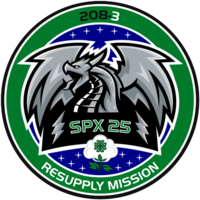SpaceX CRS-25
| Names | SpX-25 |
|---|---|
| Mission type | ISS resupply |
| Operator | SpaceX |
| Spacecraft properties | |
| Spacecraft | Cargo Dragon |
| Manufacturer | SpaceX |
| Dry mass | 9,525 kg (20,999 lb) |
| Dimensions | Height: 8.1 m (27 ft) Diameter: 4 m (13 ft) |
| Start of mission | |
| Launch date | May 2022 (planned)[1][2] |
| Rocket | Falcon 9 |
| Launch site | Kennedy Space Center, LC-39A |
| Contractor | SpaceX |
| Orbital parameters | |
| Reference system | Geocentric orbit |
| Regime | Low Earth orbit |
| Inclination | 51.66° |
| Docking with ISS | |
| Docking port | Harmony |
| RMS capture | 2022 |
| Docking date | 2022 |
 SpaceX CRS-25 mission patch Commercial Resupply Services Cargo Dragon flights | |
SpaceX CRS-25, also known as SpX-25, is a Commercial Resupply Service mission to the International Space Station (ISS) planned to be launched in May 2022.[1][2] The mission is contracted by NASA and will be flown by SpaceX using a Cargo Dragon. This will be the fifth flight for SpaceX under NASA's CRS Phase 2 contract awarded in January 2016.
Cargo Dragon[]
SpaceX plans to reuse the Cargo Dragons up to five times. The Cargo Dragon will launch without SuperDraco abort engines, without seats, cockpit controls and the life support system required to sustain astronauts in space.[3][4] This newer design provides several benefits, including a faster process to recover, refurbish and re-fly versus the earlier Dragon CRS design used for ISS cargo missions.[5]
The new Cargo Dragon capsules under the NASA CRS Phase 2 contract will splash down under parachutes in the Atlantic Ocean, east of Florida, rather than the previous recovery zone in the Pacific Ocean west of Baja California.[3][5]
Payload[]
NASA contracted for the CRS-25 mission from SpaceX and therefore determines the primary payload, date of launch, and orbital parameters for the Cargo Dragon.[6]
ISS Roll Out Solar Arrays (iROSA)[]
Second pair of new solar arrays using XTJ Prime space solar cells. They will be delivered to the station in the unpressurized trunk of the SpaceX Cargo Dragon spacecraft.[7]
The installation of these new solar arrays will require two (2) spacewalks: one to prepare the worksite with a modification kit and another to install the new panel.[8]
Research[]
The new experiments arriving at the orbiting laboratory will inspire future scientists and explorers, and provide valuable insight for researchers.
NASA Glenn Research Center studies:[9]
Student Spaceflight Experiments Program: The Student Spaceflight Experiments Program (SSEP) is selecting experiments to be manifested.[10]
Cubesats[]
CubeSats planned for this mission:[11]
See also[]
- Uncrewed spaceflights to the International Space Station
References[]
- ^ a b "Microgravity Research Flights". Glenn Research Center. NASA. 14 June 2021. Retrieved 15 June 2021.
 This article incorporates text from this source, which is in the public domain.
This article incorporates text from this source, which is in the public domain.
- ^ a b Baylor, Michael (1 September 2020). "Status - CRS-25". NextSpaceflight. Retrieved 4 April 2021.
- ^ a b Office of Inspector General (26 April 2018). Audit of Commercial Resupply Services to the International Space Center (PDF) (Report). IG-18-016. NASA. pp. 24, 28–30. Retrieved 29 September 2020.
 This article incorporates text from this source, which is in the public domain.
This article incorporates text from this source, which is in the public domain.
- ^ "Dragon 2 modifications to Carry Cargo for CRS-2 missions". Teslarati. Retrieved 29 September 2020.
- ^ a b Clark, Stephen (2 August 2019). "SpaceX to begin flights under new cargo resupply contract next year". Spaceflight Now. Retrieved 29 September 2020.
- ^ "SpaceX Commercial Resupply". ISS Program Office. NASA. 1 July 2019. Retrieved 29 September 2020.
 This article incorporates text from this source, which is in the public domain.
This article incorporates text from this source, which is in the public domain.
- ^ "Current and Future Operations and Challenges with International Space Station" (PDF). ISS Program Office. NASA. 15 October 2020. Retrieved 2 May 2021.
- ^ Clark, Stephen (13 January 2021). "Boeing says assembly complete on first set of new space station solar arrays". Spaceflight Now. Retrieved 14 January 2021.
- ^ "ISS Research Program". Glenn Research Center. NASA. 1 January 2020. Retrieved 29 September 2020.
 This article incorporates text from this source, which is in the public domain.
This article incorporates text from this source, which is in the public domain.
- ^ ssep.ncesse.org/current-flight-opportunities/ssep-mission-16-to-the-international-space-station-iss/
- ^ "Upcoming ELaNa CubeSat Launches". NASA. 6 May 2020. Retrieved 29 September 2020.
 This article incorporates text from this source, which is in the public domain.
This article incorporates text from this source, which is in the public domain.
External links[]
- SpaceX Dragon 2
- SpaceX payloads contracted by NASA
- Supply vehicles for the International Space Station
- 2022 in spaceflight
- 2022 in the United States



